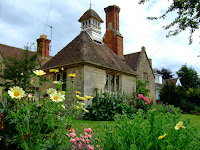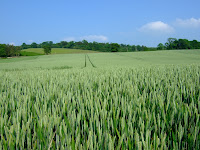 We spent the night near Alcester, and having found an excellent circular driving tour starting at Alcester we set out to follow the route. According to the BBC weather forecast, we were in the only fine spot in the country.
We spent the night near Alcester, and having found an excellent circular driving tour starting at Alcester we set out to follow the route. According to the BBC weather forecast, we were in the only fine spot in the country. We were able to complete the Shakespeare houses during the tour, as we first passed Anne Hathaway’s house; Shakespeare's wife’s family’s home. William and Anne's marriage was an unusual union: she was 26 (well and truly left on the shelf for those days) and William a minor at 18. When they married, she was 3 months pregnant, presumably a local scandal.
We were able to complete the Shakespeare houses during the tour, as we first passed Anne Hathaway’s house; Shakespeare's wife’s family’s home. William and Anne's marriage was an unusual union: she was 26 (well and truly left on the shelf for those days) and William a minor at 18. When they married, she was 3 months pregnant, presumably a local scandal.  The tour of the house was most interesting, the guide a fund of the origins of old sayings, and the “cottage” garden an absolute delight.
The tour of the house was most interesting, the guide a fund of the origins of old sayings, and the “cottage” garden an absolute delight.Next on the tour was Mary Arden House and Palmer Farm. Mary Arden was Shakespeare's mother. Although she was the youngest of 8 girls, as her father's favourite, she inherited the farm.
 This is a fascinating place to wander around, as is Palmer's Farm, next door.
This is a fascinating place to wander around, as is Palmer's Farm, next door. On with the tour, we visited a number of very picturesque villages, not at their photographic best on such a dull day though. At St Peter's in Wootten Wawen the church still houses a rare chained library.
On with the tour, we visited a number of very picturesque villages, not at their photographic best on such a dull day though. At St Peter's in Wootten Wawen the church still houses a rare chained library. One interesting side visit was to the longest aqueduct in England. This is made from cast iron plates, and passes over a road, river and 2 train lines.
One interesting side visit was to the longest aqueduct in England. This is made from cast iron plates, and passes over a road, river and 2 train lines.The final stop of the day was Ragley Hall. This house was built in 1680, and must have been very modern for it's day.
 The tour ended in a large hallway, painted by a mural painter over 14 years from 1969 to 1983. It was fascinating to see a new and fresh mural on a grand scale, incorporating family members in an epic depiction based on the Temptation of Christ and the riches of the world.
The tour ended in a large hallway, painted by a mural painter over 14 years from 1969 to 1983. It was fascinating to see a new and fresh mural on a grand scale, incorporating family members in an epic depiction based on the Temptation of Christ and the riches of the world.
































 Three of the four locks on our journey were against us and the river was still running at higher than normal flow so we were half an hour late returning the boat, but the hire people kindly did not charge us extra.
Three of the four locks on our journey were against us and the river was still running at higher than normal flow so we were half an hour late returning the boat, but the hire people kindly did not charge us extra.  Given the queue of people standing in the boatyard, the hire people were probably overjoyed to have the boat back to satisfy another customer.
Given the queue of people standing in the boatyard, the hire people were probably overjoyed to have the boat back to satisfy another customer.













